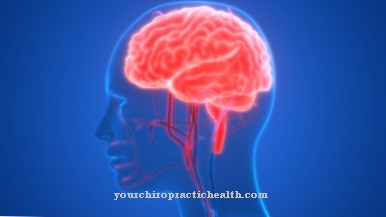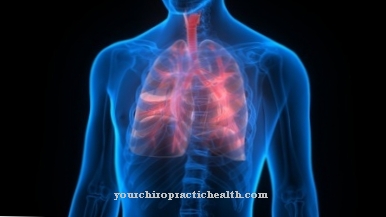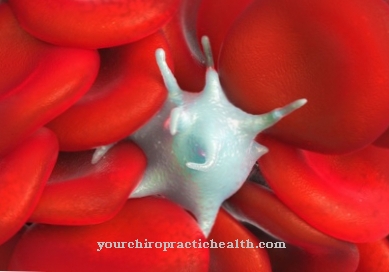Of the active mass transport is a form of transport of substrates through a biomembrane. Active transport takes place against a concentration or charge gradient and takes place with energy consumption. This process is disturbed in mitochondrial disease.
What is active mass transport?

The phospholipid and double-layer biomembranes separate individual cell compartments from one another in the human body. Due to their membrane components, the different biomembranes take on active roles in the selective transport of substances. As a separating layer between several areas, the biomembrane is inherently impermeable to the majority of all molecules. Only lipophilic, smaller and hydrophobic molecules diffuse freely through the lipid bilayer. This type of coordinated membrane permeability is also known as selective permeability.
The diffusible molecules include, for example, gas, alcohol and urea molecules. Ions and other biologically active substances are mostly hydrophilic and are held up by the biomembrane barrier. The biomembrane has transport proteins so that ions, water and larger particles such as sugar can diffuse. You are actively involved in the transport of substances. Transport through a biomembrane is also called membrane transport or membrane flow if the membrane itself shifts.
Biomembranes and their selective permeability maintain a specific cell environment inside the cell, which promotes internal functional processes. A cell and its compartments communicate with their environment and carry out selective exchange of substances and particles. Mechanisms such as active substance transport allow selective passage through the membranes on this basis. Active substance transport is to be distinguished from passive substance transport and from membrane-displacing substance transport.
Function & task
The transport of substances through a biomembrane takes place actively or passively. With passive transport, the molecules pass through the membrane in the direction of a specific concentration or potential gradient without consuming any energy. Passive transport is therefore a special form of diffusion. In this way, even larger molecules get to the other side of the membrane with the help of membrane transport proteins.
In contrast, active transport is a transport process that uses energy against the gradient of a biosystem. Different molecules can be selectively transported through the membrane against the chemical concentration gradient or the electrical potential gradient. This is particularly important for charged particles. In addition to charge aspects, concentration aspects are also relevant for their energy balance. The reduction of entropy in a closed system leads to an increase in the concentration gradient.This relationship plays just as important a role for the energy balance as the charge transport against the electric field or the resting membrane potential.
Although it is a question of a charge or energy balance in the system, the particle concentration and its change must be considered separately because of the selectively permeable biomembrane. Energy for active transport is made available on the one hand as chemical binding energy, for example in the form of the hydrolysis of ATP. On the other hand, the reduction of the charge gradient can serve as a driving force and thus generate electrical energy. The third possibility of providing energy results from an increase in the entropy present in the respective communicating system and thus from the reduction of another concentration gradient. Transport against the electrical gradient is called electrogenic. Depending on the source of energy and the type of work, a distinction is made between primary, secondary and tertiary active transport. Group translocation is a special form of active transport.
Primarily active transport occurs when ATP is consumed, with the help of which inorganic ions and protons are carried out of the cell by transport ATPases through a biomembrane. An ion is pumped, for example, from the lower concentrated to the higher concentrated side with the help of an ion pump.
The sodium-potassium pump is the primary application of this process in the human body. While consuming ATP, it pumps out positively charged sodium ions and simultaneously positively charged potassium ions into a cell. In this way, the resting potential of neurons remains constant and action potentials can be generated and passed on.
With secondary active transport, particles are transported along the electrochemical gradient. The potential energy of the gradient is used as a drive to transport a second substrate in the same direction against the electrical gradient or concentration gradient. This active transport plays a role especially for the sodium-glucose symport in the small intestine. If the second substrate is transported in the opposite direction, there can also be an active secondary mass transport, for example in the case of the sodium-calcium antiport by means of a sodium-calcium exchanger.
Tertiary active transport uses a concentration gradient established by secondary active transport based on primarily active transport. This type of transport plays a role primarily for the di- and tripeptide transport in the small intestine, which is carried out by the peptide transporter 1. The group translocation transports monosaccharides or sugar alcohols as a special form of active substance transport and changes the transport substances chemically through phosphorylation. The phosphoenolpyruvic acid phosphotransferase system is the most important example of this mode of transport.
Illnesses & ailments
The energy metabolism as well as special transporter enzymes and transporter proteins play a role in the active transport of substances. If the transporter proteins or enzymes in question are not present in their originally physiologically planned form due to mutations or errors in the transcription of the genetic material, the active transport of substances is only more difficult or, in extreme cases, no longer possible at all.
For example, some diseases of the small intestine are associated with this phenomenon. Diseases with impaired ATP supply can also have devastating effects on the active transport of substances and cause functional disorders in various organs. Only in a few cases of such diseases is only a single organ affected. Energy metabolism disorders are mostly multi-organ diseases that often have a genetic basis.
In all mitochondrial diseases, for example, the enzyme system is affected, which is involved in the production of energy through oxidative phosphorylation. These disorders include, in particular, the disruption of ATP synthase. This enzyme is one of the most important transmembrane proteins and appears, for example, as a transport enzyme in the proton pump. The main task of the enzyme is to catalyze the synthase of ATP. In order to provide energy, the ATP synthase links the energetically favored proton transport with the formation of ATP along the proton gradient. This makes ATP synthase one of the most important energy converters in the human body and can transform one form of energy into other forms of energy. Mitochondrial diseases are malfunctions of the mitochondrial metabolic processes and lead to a reduced performance of the body due to the reduced synthesis of ATP.


























